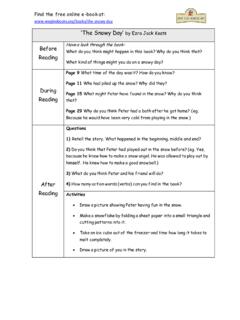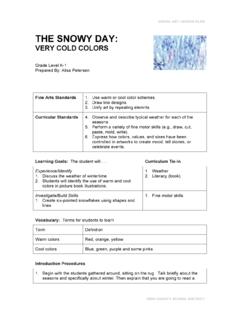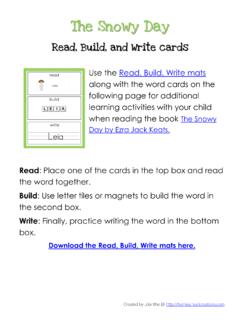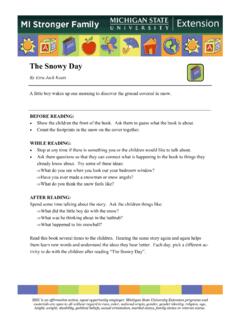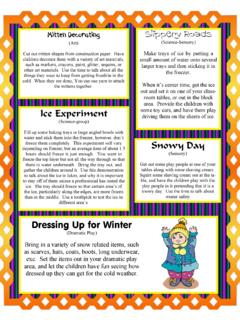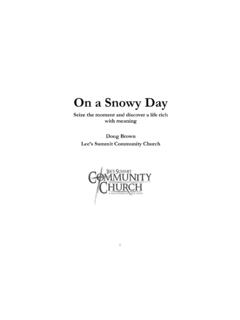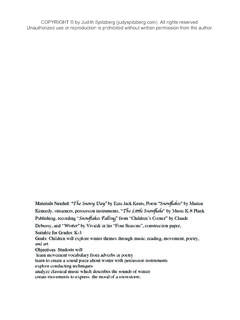Transcription of PURPOSE STATEMENT - ohgraceg.teachforus.org
1 Planning Guide for Interactive Read-Aloudsincluding vocabulary development and reading comprehension strategies STORY: The snowy Day by Ezra Jack Keats MAIN IDEA: Sometimes good things come to an end; When we re having so much fun and enjoying something, we want it to last forever. We are sad when it comes to an end. FINAL WHY QUESTION: Why did Peter want to save his snowball? OR Why did Peter dream that the sun had melted all the snow away? STORY PROBLEM: When Peter s snowball melted he was worried that all the snow outside would also melt. Then he wouldn t get to enjoy another fun day in the snow.
2 FIRST READ: Push in key eventsSECOND READ: Push in character s thoughts, feelings, actionsTHIRD READ: Pull out Putting it all together(if necessary push in information that helps children infer the answer to the final why question)WHY QUESTION:Why was Peter s pocket empty?WHY QUESTION:Why was Peter thinking so much while he was in the bathtub?WHY QUESTION:Why did Peter want to save his snowball?POSSIBLE ANSWERS: Because the snow had melted. The solid snow turned into water while it was inside his warm house. He just had an empty, wet pocket. POSSIBLE ANSWERS: Because he had so much fun in the snow and maybe he wondered if all the snow would still be there the next day.
3 He remembered all the fun he had outside and he didn t want to forget it. Peter thought about his adventures and what he might do the next time he plays in the snow. He was thinking about the snowball in his pocket. POSSIBLE ANSWERS: He had so much fun in the snow. He didn t want the fun to end. He wanted to save it. Maybe he thought if he saved the snowball he could make the fun in the snow last a little longer. Because he was thinking about how much he didn t want the snow to go away and he was afraid that it would go STATEMENT :This little boy Peter looks like he is having the best time in the snow.
4 I wonder what kind of adventures he has on this snowy day. Let s read and find STATEMENT :Remember when Peter was taking his bath after he had played in the snow (refer to illustration)? He just sat there for a long time. I wonder what he was thinking about. Let s read it again and find out. PURPOSE STATEMENT :Remember when Peter put the snowball in his pocket? I wonder why he did that. Let s go through the book and see if we can find out. ASSESSMENT (FIRST AND SECOND READS): The supporting teacher should observe students and note how they engage in the read aloud time using the recording form at the end of the lesson plan.
5 You will use this same form for all first and second readings, so don t feel that you need to record observations of all students every day. Instead, choose 4-5 students to observe daily. ASSESSMENT (THIRD READING):Utilize the Student Responses Note-Taking Form at the end of the lesson plan to record student responses to the prompted questions during the third reading. When students are think-pair-sharing choose 1-2 students to listen carefully to and record their responses. Print two copies of this form so both the lead teacher and supporting teacher can take notes.
6 Be sure to capture responses from a wide range of students (perhaps using a turn-taking cup with student names in it). Looking over this data will give you a pulse on how students internalized the learning from the first two readings of the story. Lesson Plan Key*: rhetorical question we often ask rhetorical questions to model for students how we ask questions while we read, and to prompt them pay attention to a certain aspect of the story so they can begin reading for a PURPOSE . : These arrows represent places where you can connect events in the story. Read the current page, then turn back to the page(s) indicated after the arrow to connect events for the : Superscripted numbers are inserted into the text indicating places where you should comment or think aloud.
7 If no superscripted numbers are present you should save the talking points until the end of that page.^: Vocabulary previously introduced, review as necessaryP, A: Superscripted letters are inserted into the text indicating places where you should point to the illustration or dramatize to help students understand specific highlighting: Any part highlighted in blue should be personalized to you and your class. The snowy DayFirst Read Vision for Student PerformanceWhat will you support students to do with this text? What big ideas must they understand in order to fully understand the book?
8 How will you get students to that level of understanding? The PURPOSE of the first reading is to push in the main events in the story and how events connect throughout the book. An understanding of the main events in the story will lead students to answer the why question of the day (Why was Peter s pocket empty?). Note: you will do the majority of the talking today, modeling for students how to think about text, explaining the events of the story and how they connect. The post-reading discussion will involve students more heavily. Something else to note about the scripting you see in these plans is that it is intentionally at a high level of language sophistication.
9 We are intentionally trying to lift the language beyond the typical speech patterns of 3-4 year old students. When you are thinking aloud, use your normal grown up speech do not try to use baby talk or language that is less sophisticated. BEHAVIOR & PROCEDURESWhat behavior expectations will you set for students? What procedures will students need to perform? What student-friendly language will you use to explain these? How will you model or demonstrate? Transition to the carpet - students will transition to the carpet while teacher provides commentary on those following procedure (Tom is using his walking feet!)
10 Look at Shauna sitting with pretzel legs already!) and redirect those not following Attention Procedure stop what you re doing, look at the teacher (or the friend who is talking), listen carefullyTurn and Talk procedure for turning to a neighbor and sharing an idea students should find a partner quickly (these may be assigned), take turns sharing their ideas (should be on topic based on teacher prompt), and wrap up their sharing when the teacher counts down from 5 to up/down Procedure for answering yes/no questions READ ALOUD RULES Stay seated on your bottom so that everyone can see the story.
